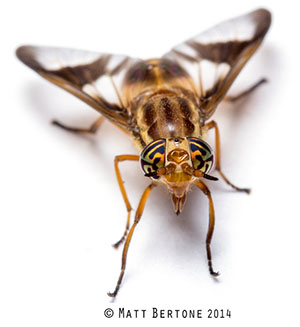Deer Flies Hunting for a Meal
go.ncsu.edu/readext?415574
en Español / em Português
El inglés es el idioma de control de esta página. En la medida en que haya algún conflicto entre la traducción al inglés y la traducción, el inglés prevalece.
Al hacer clic en el enlace de traducción se activa un servicio de traducción gratuito para convertir la página al español. Al igual que con cualquier traducción por Internet, la conversión no es sensible al contexto y puede que no traduzca el texto en su significado original. NC State Extension no garantiza la exactitud del texto traducido. Por favor, tenga en cuenta que algunas aplicaciones y/o servicios pueden no funcionar como se espera cuando se traducen.
Português
Inglês é o idioma de controle desta página. Na medida que haja algum conflito entre o texto original em Inglês e a tradução, o Inglês prevalece.
Ao clicar no link de tradução, um serviço gratuito de tradução será ativado para converter a página para o Português. Como em qualquer tradução pela internet, a conversão não é sensivel ao contexto e pode não ocorrer a tradução para o significado orginal. O serviço de Extensão da Carolina do Norte (NC State Extension) não garante a exatidão do texto traduzido. Por favor, observe que algumas funções ou serviços podem não funcionar como esperado após a tradução.
English
English is the controlling language of this page. To the extent there is any conflict between the English text and the translation, English controls.
Clicking on the translation link activates a free translation service to convert the page to Spanish. As with any Internet translation, the conversion is not context-sensitive and may not translate the text to its original meaning. NC State Extension does not guarantee the accuracy of the translated text. Please note that some applications and/or services may not function as expected when translated.
Collapse ▲If you’ve been outdoors working or jogging or horseback riding along tree-lined trails, you’ve probably had the misfortune of being harassed by deer flies or horse flies searching for a meal.
Deer flies range in length from 1/3″ to 4/10″. Horse flies are slightly larger and can be nearly 1″ in length. Deer flies are yellowish and have dark stripes on their thorax and abdomen. Their wings have dark patches.
Deer flies pass the winter at larvae and mature in the spring. Adult flies show up primarily in May-August (depending on the weather). Similar to mosquitoes, only female deer flies and horse flies bite animals to obtain a blood meal which they use to produce eggs. Males feed on plant nectar. The females attack animals along hiking trails and the edges of wooded areas. They have mouthparts equipped with a pair of blades which make the incision in your skin. They then use the sponge-like part to soak up the blood that pools on the skin surface. Eggs are laid on foliage in wet-to-flooded (and often shaded) areas. They hatch in about a week and the larvae drop to the ground where they prey on small invertebrates and on organic matter.
People ask about what they can spray for the flies. Unfortunately, trying to spray adults isn’t effective because they are a moving target and it’s too difficult to identify and spray landing/resting areas on shrubs and other vegetation as we do for mosquitoes. Targeting breeding sites is equally difficult (and often environmentally complicated). Adults can be trapped using shiny black balls (resembling bowling balls) or using a dark plastic cup covered with glue. These traps are hung and must be moving with wind currents to attract the flies. (see http://entnemdept.ufl.edu/creatures/livestock/deer_fly.htm)
The best option for people spending time outdoors is to use repellents but keep in mind if you’re out there for work or exercise, you’re also sweating which reduces the length of time that the repellent is effective and you’ll need to reapply it.
For more information about deer flies and horse flies, visit: https://www.ces.ncsu.edu/depts/ent/notes/Urban/horsefly.htm
Picture of deer fly from Matt Bertone’s Flickr site: (https://c2.staticflickr.com/8/7430/14150745996_5a32466bd6_b.jpg)



